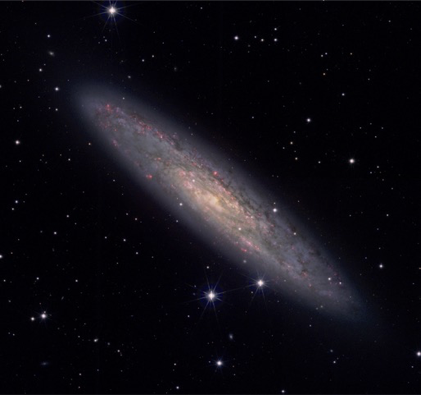O modelo padrão atual da Cosmologia, ΛCDM, tem o Princípio Cosmológico (PC) como uma de suas hipóteses fundamentais, de modo que a métrica de fundo do Universo consiste na métrica Friedman-Lemaître-Robertson-Walker (FLRW). Assim, assume-se que o Universo é isotrópico e homogêneo em grandes escalas. Apesar do bom acordo entre o modelo ΛCDM (bem como demais modelos FLRW) e as observações cosmológicas, testes diretos do PC ainda precisam ser realizados para verificar se, de fato, o PC é uma hipótese válida ou tão apenas uma simplificação matemática.
Neste seminário, apresentarei um teste da isotropia cosmológica que fez uso da distribuição angular de galáxias da amostra WISE x SuperCOSMOS (WISC). Mais precisamente, verificamos se o dipolo desta distribuição está de acordo com análises anteriores na literatura, e de acordo com a amplitude típica de simulações baseadas no modelo ΛCDM. Além disto, discutirei brevemente sobre uma análise similar realizada recentemente com fontes em rádio, além das expectativas que surveys futuros, como o Square Kilometer Array (SKA), poderiam lançar sobre a isotropia cosmológica.
Referência dos trabalhos: https://arxiv.org/abs/1707.08091 e https://arxiv.org/abs/1710.08804Abstract: O modelo padrão atual da Cosmologia, ΛCDM, tem o Princípio Cosmológico (PC) como uma de suas hipóteses fundamentais, de modo que a métrica de fundo do Universo consiste na métrica Friedman-Lemaître-Robertson-Walker (FLRW). Assim, assume-se que o Universo é isotrópico e homogêneo em grandes escalas. Apesar do bom acordo entre o modelo ΛCDM (bem como demais modelos FLRW) e as observações cosmológicas, testes diretos do PC ainda precisam ser realizados para verificar se, de fato, o PC é uma hipótese válida ou tão apenas uma simplificação matemática.
Neste seminário, apresentarei um teste da isotropia cosmológica que fez uso da distribuição angular de galáxias da amostra WISE x SuperCOSMOS (WISC). Mais precisamente, verificamos se o dipolo desta distribuição está de acordo com análises anteriores na literatura, e de acordo com a amplitude típica de simulações baseadas no modelo ΛCDM. Além disto, discutirei brevemente sobre uma análise similar realizada recentemente com fontes em rádio, além das expectativas que surveys futuros, como o Square Kilometer Array (SKA), poderiam lançar sobre a isotropia cosmológica.
Referência dos trabalhos: https://arxiv.org/abs/1707.08091 e https://arxiv.org/abs/1710.08804


